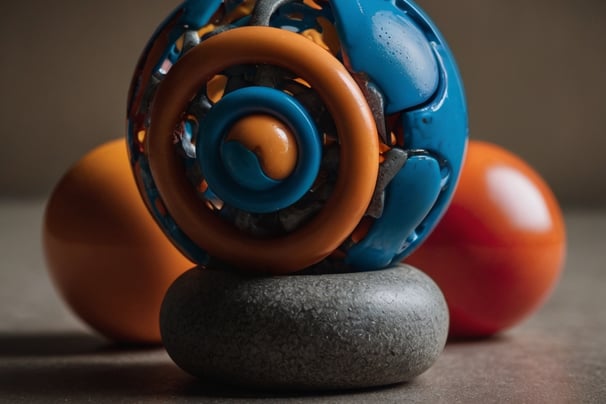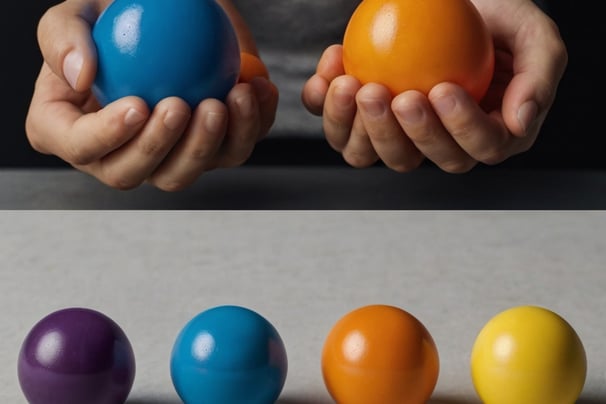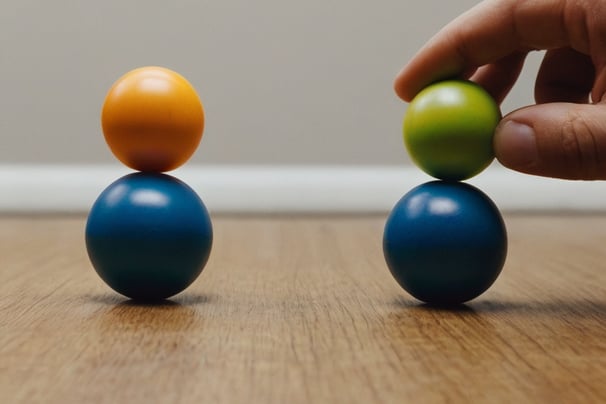
Stress Balls vs. Fidget Toys: Which Is Best for Stress Relief?
"Curious about how Stress Balls vs. Fidget Toys stack up when it comes to stress relief? Explore this comprehensive guide where we break down their unique benefits, key differences, and which is truly best for calming your mind and body. Find the answers and discover valuable insights that could transform your stress management routine!"
TOYS FOR STRESS RELIEF
1/13/20257 min read
Stress and anxiety are increasingly common in today’s fast-paced world. People seek a variety of ways to cope with these pressures, and one method that has gained widespread popularity is the use of stress-relieving tools like stress balls and fidget toys. Both tools offer physical outlets to help alleviate stress, but the question remains: which is best for stress relief? This blog will delve into the effectiveness of stress balls and fidget toys, exploring their psychological and physical benefits, as well as providing a comprehensive answer to the question based on available research and findings.
Many individuals turn to tools like these in response to the rising prevalence of workplace stress and burnout, as highlighted in our article on the science of burnout. As more companies focus on fostering better mental wellness among employees, the use of stress-relief tools like fidget toys and stress balls is becoming part of broader initiatives. Understanding how they can impact stress is crucial to addressing workplace challenges, much like the strategies discussed in the article on the mindfulness at work and on the techniques to stay calm and focused and well as on the employee assistance programs.These methods provide individuals with personal ways to alleviate stress, complementing workplace strategies.
Additionally, for individuals dealing with workplace challenges like bullying or poor emotional intelligence in leadership, as explored in our work on the impact of workplace bullying on stress levels and the role of emotional intelligence in managing workplace stress, stress-relieving tools like stress balls or fidget toys may serve as a simple, effective way to regain control in difficult situations.
Stress Balls vs. Fidget Toys: Which Is Best for Stress Relief?
When it comes to choosing between stress balls and fidget toys, the answer is not always clear-cut. The best tool depends on several factors, such as the individual's preferences, the type of stress or anxiety they are experiencing, and the context in which they are using the tool.
Both stress balls and fidget toys serve different purposes: stress balls are simple and effective for quick physical relief, while fidget toys offer a more multifaceted approach to both mental engagement and focus.
By considering their unique benefits, limitations, and real-world applications, we can better understand which option might work best for different needs.


Stress Balls: A Simple and Effective Tool for Anxiety Relief
Stress balls are one of the most widely recognized tools for managing anxiety and physical tension. These small, squeezable objects have been used for decades to offer quick relief in moments of stress.
The primary benefit of stress balls is their simplicity—by squeezing the ball, individuals can focus their attention on the physical sensation and release pent-up energy or anxiety. This repetitive motion helps reduce tension and can create a calming effect, which makes it a popular choice for many people.
Stress balls have been particularly effective in medical settings, where individuals are often dealing with high levels of stress or anxiety. A study by Ozen, Berse, and Tosun (2023) found that patients undergoing hemodialysis experienced significant reductions in both anxiety and depression after using stress balls regularly. T
he study concluded that the act of squeezing the ball helped patients redirect their attention away from negative emotions and allowed them to focus on the task at hand. This offers a simple and effective form of stress relief, especially when individuals need to calm down in the midst of a stressful situation.
Moreover, stress balls are portable and easy to use, making them ideal for individuals who need a quick and discreet method of relieving stress in various environments, such as in meetings, classrooms, or public spaces. The physical motion of squeezing the ball can also help to alleviate muscle tension, particularly in the hands and forearms, which are common areas where stress manifests.
Key Findings
Stress balls provide immediate physical relief by reducing muscle tension and promoting relaxation.
They are effective in reducing anxiety and depression, particularly in clinical settings such as hospitals or during medical treatments.
The simplicity of the tool makes it widely accessible and easy to use for people of all ages.
However, stress balls may not address the cognitive aspects of stress, which can make them less effective for managing long-term or chronic stress.


Fidget Toys: A Multifaceted Approach to Managing Stress
Fidget toys, including items like fidget spinners, cubes, and rings, have become increasingly popular in recent years, especially among people who struggle with focus or attention.
Unlike stress balls, which offer a singular focus on physical tension release, fidget toys provide a more dynamic experience.
They often have multiple components that users can engage with, such as buttons, switches, or spinning wheels, allowing for a continuous, low-level distraction that can help manage both stress and anxiety.
While stress balls provide an immediate outlet for anxiety and physical stress, fidget toys are often more suited for individuals who need to focus their energy or attention over a longer period of time. Research suggests that fidget toys can be particularly effective in environments where individuals need sustained attention, such as in classrooms or workplaces.
A study by Kriescher et al. (2023) found that fidget toys helped students with attention difficulties stay focused during tasks, as the toys provided an outlet for their restlessness. By channeling nervous energy into the toys, students were able to concentrate better on their work.
Fidget toys also engage both the body and mind, offering a form of active distraction that helps people stay grounded during stressful moments. For instance, the tactile stimulation of a fidget spinner or the action of flipping a fidget cube provides a mental diversion from anxious thoughts.
However, while fidget toys can help manage anxiety for some, the scientific evidence supporting their widespread use as a tool for reducing anxiety is still limited. Some users find them helpful, while others may experience only a minimal effect.
Key Findings
Fidget toys provide an interactive way to manage anxiety by offering both mental and physical engagement.
Studies suggest that fidget toys are effective in maintaining focus, especially for individuals with ADHD or attention difficulties.
However, their impact on anxiety relief is still debated, with some users experiencing minimal effects.
They may not be as effective in situations where quick, immediate relief is needed, such as during high-stress or emergency situations.
Comparing the Two: What Do the Studies Say?
When comparing stress balls and fidget toys, it's clear that each tool has its own strengths and limitations. Stress balls are particularly beneficial for individuals seeking immediate relief from physical tension and anxiety.
They are a quick and effective way to manage stress in environments where rapid relaxation is required, such as in medical settings, during exams, or in stressful work situations.
However, stress balls are primarily a physical tool and may not help with managing mental distractions or maintaining focus for long periods.
Fidget toys, on the other hand, offer a more comprehensive approach to managing stress. They are effective in environments where sustained focus is required, such as classrooms, offices, or study sessions.
Research by Croley et al. (2022) highlighted that fidget cubes helped students with perceived attention difficulties stay on task, which shows their potential to improve focus and productivity.
However, their impact on anxiety relief is less clear, with some studies suggesting that they are more effective for managing restlessness or maintaining concentration rather than directly addressing anxiety.
Takeaways
Stress Balls: Excellent for immediate physical stress relief, especially in settings that require quick relaxation.
Fidget Toys: Better for improving focus and concentration over extended periods but with mixed results for anxiety relief.


The Psychological and Physiological Benefits
Both stress balls and fidget toys offer unique benefits, and understanding their psychological and physiological effects can help us make an informed decision about which tool to use.
Stress balls primarily offer a physiological benefit by relieving muscle tension and promoting relaxation. The act of squeezing the ball can activate muscles in the hands and forearms, which helps to reduce the overall feeling of physical tension. This simple action can have a calming effect on both the mind and body.
Fidget toys, on the other hand, offer a dual benefit—both psychological and physiological.
By engaging the hands in repetitive motion, fidget toys keep the user’s mind occupied, which can help distract from negative or anxious thoughts. This type of mental engagement is particularly useful in situations where people need to stay focused for extended periods.
The constant motion helps to redirect energy from anxious thoughts to physical actions, offering a more comprehensive solution for managing stress over time.
Takeaways
Stress Balls: Help reduce physical tension, promote relaxation, and offer immediate anxiety relief.
Fidget Toys: Help maintain focus and attention over time, provide a mental distraction, and keep restless hands engaged.


Conclusion: Which One Should You Choose for Stress Relief?
After evaluating both stress balls and fidget toys, it's clear that each tool offers distinct advantages depending on the user's needs and the context in which they are used. Stress balls are ideal for individuals who need quick physical relief from anxiety or tension, especially in high-pressure situations where immediate calming is required. They are effective for reducing physical stress and are easy to use in a variety of settings, making them a great option for anyone in need of a quick, discreet solution.
On the other hand, fidget toys are more suited for people who need to maintain focus and concentration over a longer period, particularly in situations like studying, working, or attending meetings. They help channel restless energy and keep the mind engaged, but their ability to relieve anxiety is still debated. While fidget toys may not provide instant relief like stress balls, they offer a longer-term solution for managing focus and attention, especially for individuals with ADHD or attention-related difficulties.
Ultimately, the choice between stress balls and fidget toys depends on your specific needs. If you're looking for immediate relief from anxiety or physical tension, a stress ball is your best bet. But if you need something to help you maintain focus and concentration throughout a stressful day, a fidget toy might be more beneficial. Both tools have their place in stress management, and their effectiveness will depend on individual preferences, the type of stress being managed, and the context in which they are used.
References:
Kriescher, S. L., Hulac, D. M., Ryan, A. M., & King, B. L. (2023). Evaluating the Evidence for Fidget Toys in the Classroom. Intervention in School and Clinic, 59(1), 66-69.
Croley, K. E., Drevon, D. D., Decker, D. M., Hixson, M. D., & Radley, K. C. (2022). The Effect of the Fidget Cube on Classroom Behavior among Students with Perceived Attention Difficulties. Behavior analysis in practice, 16(2), 547–557.
Ozen, N., Berse, S., & Tosun, B. (2023). Effects of using a stress ball on anxiety and depression in patients undergoing hemodialysis: A prospective, balanced, single-blind, crossover study. Hemodialysis International, 27(3), 325–333.Aspiranti, K. B., & Hulac, D. M. (2021). Using Fidget Spinners to Improve On-Task Classroom Behavior for Students With ADHD. Behavior analysis in practice, 15(2), 454–465.
